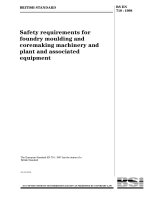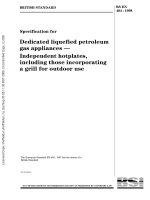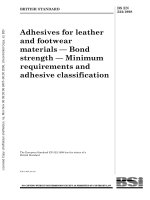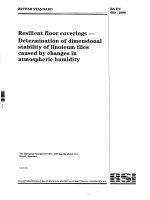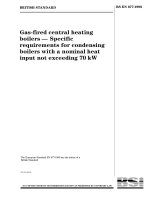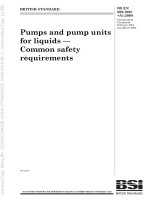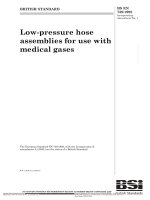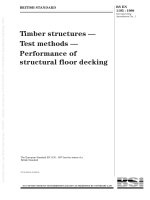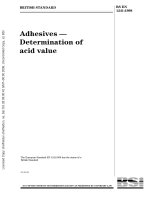Bsi bs en 61642 1998
Bạn đang xem bản rút gọn của tài liệu. Xem và tải ngay bản đầy đủ của tài liệu tại đây (1.14 MB, 34 trang )
BRITISH STANDARD
Industrial a.c. networks
affected by
harmonics —
Application of filters
and shunt capacitors
The European Standard EN 61642:1997 has the status of a
British Standard
ICS 31.060.99; 31.160
BS EN
61642:1998
IEC 61642:
1997
BS EN 61642:1998
National foreword
This British Standard is the English language version of EN 61642:1997. It is
identical with IEC 61642:1997.
The UK participation in its preparation was entrusted to Technical Committee
PEL/33 Power capacitors, which has the responsibility to:
— aid enquirers to understand the text;
— present to the responsible international/European committee any
enquiries on the interpretation, or proposals for change, and keep the
UK interests informed;
— monitor related international and European developments and
promulgate them in the UK.
A list of organizations represented on this committee can be obtained on
request to its secretary.
From 1 January 1997, all IEC publications have the number 60000 added to
the old number. For instance, IEC 27-1 has been renumbered as IEC 60027-1.
For a period of time during the change over from one numbering system to the
other, publications may contain identifiers from both systems.
Cross-references
Attention is drawn to the fact that CEN and CENELEC Standards normally
include an annex which lists normative references to international
publications with their corresponding European publications. The British
Standards which implement these international or European publications may
be found in the BSI Standards Catalogue under the section entitled
“International Standards Correspondence Index”, or by using the “Find”
facility of the BSI Standards Electronic Catalogue.
A British Standard does not purport to include all the necessary provisions of
a contract. Users of British Standards are responsible for their correct
application.
Compliance with a British Standard does not of itself confer immunity
from legal obligations.
Summary of pages
This document comprises a front cover, an inside front cover, pages i and ii,
the EN title page, pages 2 to 28 and a back cover.
This standard has been updated (see copyright date) and may have had
amendments incorporated. This will be indicated in the amendment table on
the inside front cover.
This British Standard, having
been prepared under the
direction of the Electrotechnical
Sector Board, was published
under the authority of the
Standards Board and comes
into effect on
15 January 1998
© BSI 04-1999
ISBN 0 580 29473 0
Amendments issued since publication
Amd. No.
Date
Comments
BS EN 61642:1998
Contents
National foreword
Foreword
Text of EN 61642
© BSI 04-1999
Page
Inside front cover
2
5
i
ii
blank
EN 61642
EUROPEAN STANDARD
NORME EUROPÉENNE
EUROPÄISCHE NORM
October 1997
ICS 31.060.99; 31.160
Descriptors: Capacitors, shunts, power capacities, alternating current, electric filters, definitions, generalities
English version
Industrial a.c. networks affected by harmonics
Application of filters and shunt capacitors
(IEC 61642:1997)
Réseaux industriels à courant alternatif
affectés par les harmoniques — Emploi de
filtres et de condensateurs shunt
(CEI 61642:1997)
Von Overschwingungen beeinflußte
industrielle Wechselstromnetze Anwendung
von Filtern und Parallelkondensatoren
(IEC 61642:1997)
This European Standard was approved by CENELEC on 1997-10-01.
CENELEC members are bound to comply with the CEN/CENELEC Internal
Regulations which stipulate the conditions for giving this European Standard
the status of a national standard without any alteration.
Up-to-date lists and bibliographical references concerning such national
standards may be obtained on application to the Central Secretariat or to any
CENELEC member.
This European Standard exists in three official versions (English, French,
German). A version in any other language made by translation under the
responsibility of a CENELEC member into its own language and notified to the
Central Secretariat has the same status as the official versions.
CENELEC members are the national electrotechnical committees of Austria,
Belgium, Denmark, Finland, France, Germany, Greece, Iceland, Ireland, Italy,
Luxembourg, Netherlands, Norway, Portugal, Spain, Sweden, Switzerland and
United Kingdom.
CENELEC
European Committee for Electrotechnical Standardization
Comité Européen de Normalisation Electrotechnique
Europäisches Komitee für Elektrotechnische Normung
Central Secretariat: rue de Stassart 35, B-1050 Brussels
© 1997 CENELEC — All rights of exploitation in any form and by any means reserved worldwide for
CENELEC members.
Ref. No. EN 61642:1997 E
EN 61642:1997
Foreword
The text of document 33/255/FDIS, future edition 1
of IEC 61642, prepared by IEC TC 33, Power
capacitors, was submitted to the IEC-CENELEC
parallel vote and was approved by CENELEC as
EN 61642 on 1997-10-01.
The following dates were fixed:
— latest date by which the
EN has to be implemented
at national level by
publication of an identical
national standard or by
endorsement
(dop) 1998-07-01
— latest date by which the
national standards
conflicting with the EN
have to be withdrawn
(dow) 1998-07-01
IEC 60269, NOTE Harmonized in the EN 60269 series and in
the HD 630 series.
IEC 60282, NOTE Harmonized as EN 60282-1:1996 (not
modified) and as HD 636 S1:1996 (not modified).
IEC 60289, NOTE Harmonized as EN 60289:1994 (modified).
IEC 60831-1, NOTE Harmonized as EN 60831-1:1996 (not
modified).
IEC 60871-1, NOTE Harmonized as HD 525.1 S1:1989 (not
modified).
IEC 60871-2, NOTE Harmonized as HD 525.2 S1:1989 (not
modified).
IEC 60931-1, NOTE Harmonized as EN 60931-1:1996 (not
modified).
IEC 61000-2-2, NOTE Harmonized as ENV 61000-2-2:1993
(modified).
Annexes designated “normative” are part of the
body of the standard. Annexes designated
“informative” are given for information only. In this
standard, Annex ZA is normative and Annex A is
informative. Annex ZA has been added by
CENELEC.
Endorsement notice
The text of the International Standard
IEC 61642:1997 was approved by CENELEC as a
European Standard without any modification.
In the official version, for Annex A, Bibliography,
the following notes have to be added for the
standards indicated:
IEC 60110, NOTE Harmonized as HD 207 S1:1977 (not
modified).
IEC 60143, NOTE Harmonized in the EN 60143 series.
IEC 60358, NOTE Harmonized as HD 597 S1:1992 (not
modified).
IEC 60252, NOTE Harmonized as EN 60252:1994 (modified).
IEC 61048, NOTE Harmonized, together with its
corrigendum 1992, as EN 61048:1993 (modified).
IEC 61049, NOTE Harmonized, together with its
corrigendum 1992, as EN 61049:1993 (modified).
IEC 60056, NOTE Harmonized, together with its
amendments 1:1992 and 2:1995, as HD 348 S6:1995.
IEC 60255-6, NOTE Harmonized as EN 60255-6:1994
(modified).
IEC 60265-1, NOTE Harmonized, together with its
amendments 1:1984 and 2:1994, as HD 355.1 S3:1995 (not
modified).
IEC 60265-2, NOTE Harmonized, together with its
corrigendum 1990, as EN 60265-2:1993 (not modified).
2
© BSI 04-1999
EN 61642:1997
Contents
1
1.1
1.2
1.3
1.4
1.4.1
1.4.2
2
2.1
2.2
2.3
2.4
2.5
2.5.1
2.5.2
3
3.1
3.2
3.3
3.4
3.5
3.5.1
3.5.2
3.5.3
3.5.4
3.6
3.6.1
3.6.2
3.6.3
4
4.1
4.2
4.3
4.4
4.5
General
Scope and object
Normative references
Definitions
General considerations
AC harmonics
Reactive power
Resonance problems and solutions
Introduction
Supply impedance view,
load-busbar impedance view
Example of series resonance
Example of parallel resonance
Solutions to avoid resonances
Capacitor-reactor connection:
series resonance
Capacitor-reactor connection:
parallel resonance
Shunt capacitors and filters for
networks having a voltage up to
and including 1 000 V
Introduction
Shunt capacitors
Detuned filter
Tuned filter
Components selection
Capacitors
Reactors
Contactors and/or circuit-breakers
Short-circuit protection (fuses)
Disturbance of ripple control
installations by shunt capacitors
and filters
Shunt capacitors
Detuned filter
Tuned filter
Shunt capacitors and filters for
networks having a voltage
above 1 000 V
Introduction
Specific requirements
Choice of power factor
correction installation
Type of filters
Filter components selection
© BSI 04-1999
Page
5
5
5
5
7
7
7
7
7
8
10
12
13
14
16
18
18
18
18
19
19
20
20
20
20
21
21
21
22
23
23
23
23
24
24
4.5.1
4.5.2
4.5.3
4.5.4
4.5.5
4.6
Circuit-breaker
Capacitors
Reactors
Resistors
Relay protection
Disturbance of ripple control
installations by shunt capacitors
and filters
Annex A (informative) Bibliography
Annex ZA (normative) Normative references
to international publications with their
corresponding European publication
Figure 1 — Simplified network and
one-line diagram
Figure 2a — Supply impedance view of
a network and one-line diagram
Figure 2b — Load-busbar impedance view
of a network and one-line diagram
Figure 3a — One-line diagram of a
series resonance circuit
Figure 3b — Impedance in ohms
versus harmonic order of the circuit
shown in Figure 3a
Figure 4a — One-line diagram of a
parallel resonance circuit
Figure 4b — Impedance in ohms
versus harmonic order of the circuit
shown in Figure 4a
Figure 5a — One-line diagram of a
series resonance circuit with
capacitor-reactor connection
Figure 5b — Impedance in ohms
versus harmonic order h of the circuit
shown in Figure 5a
Figure 6a — One-line diagram of a
parallel resonance circuit with
capacitor-reactor connection
Figure 6b — Impedance in ohms
versus harmonic order of the circuit
shown in Figure 6a
Figure 7a — One-line diagram of
transformer-capacitor arrangement
Figure 7b — Relative impedance Z RC/Z 1
Figure 7c — Relative signal
voltage URC /URCO
Figure 8 — Types of filters for
high-voltage applications
Page
24
25
25
25
25
25
27
28
8
9
9
10
10
12
12
14
15
16
17
22
22
23
26
3
EN 61642:1997
Table 1 — Numerical results of
impedances, voltages and currents at
characteristic harmonic orders of a
series resonance circuit in a network with
a distorted supply voltage
Table 2 — Numerical results of
impedances, voltages and currents at
characteristic harmonic orders of a parallel
resonance circuit in the presence of a
harmonic current source.
Table 3 — Numerical results of
impedances, voltages and currents at
characteristic harmonic orders of a series
resonance circuit with a
capacitor-reactor-connection in a network
with distorted supply voltage
Table 4 — Numerical results of
impedances, voltages and currents at
characteristic harmonic orders of a
parallel resonance circuit with a
capacitor-reactor-connection in the presence
of a harmonic current source
4
Page
11
13
16
18
© BSI 04-1999
EN 61642:1997
1 General
1.1 Scope and object
This International Standard gives guidance for the use of passive a.c. harmonic filters and shunt capacitors
for the limitation of harmonics and power factor correction intended to be used in industrial applications,
at low and high voltages. The measures proposed in this standard are applicable to harmonic orders greater
than 1 and up to and including 25.
The following capacitors are excluded from this standard:
— capacitors for inductive heat generating plants, operating at frequencies between 40 Hz
and 24 000 Hz (see IEC 60110 [1] 1) );
— series capacitors for power systems (see IEC 60143 [2]);
— coupling capacitors and capacitor dividers (see IEC 60358 [3]);
— power electronic capacitors (see IEC 61071 [4]);
— AC motor capacitors (see IEC 60252 [5]);
— capacitors for use in tubular fluorescent and other discharge lamp circuits (see IEC 61048 [6] and
IEC 61049 [7]);
— capacitors for the suppression of radio interference;
— capacitors intended to be used in various types of electric equipment and thus considered as
components;
— capacitors intended for use with d.c. voltage superimposed on a.c. voltage;
— capacitors intended for use with arc furnaces.
The object of this standard is to identify problems and give recommendations for general applications of
capacitors and a.c. harmonic filters in a.c. power systems affected by the presence of harmonic voltages and
currents.
1.2 Normative references
The following normative documents contain provisions which, through reference in this text, constitute
provisions of this International Standard. At the time of publication, the editions indicated were valid. All
normative documents are subjected to revision, and parties to agreements based on this International
Standard are encouraged to investigate the possibility of applying the most recent editions of the normative
documents indicated below. Members of IEC and ISO maintain registers of currently valid International
Standards.
IEC 60050(131):1978, International Electrotechnical Vocabulary (IEV) — Chapter 131: Electric and
magnetic circuits.
IEC 60050(161):1990, International Electrotechnical Vocabulary (IEV) — Chapter 161: Electromagnetic
compatibility.
1.3 Definitions
For the purpose of this International Standard, the following definitions apply.
1.3.1
harmonic
the component of the Fourier-series decomposition of a voltage or current periodic wave
[IEV 161-02-18 modified]
1.3.2
harmonic order, h
the ratio of the frequency of a harmonic (fh) to the fundamental (rated) network frequency (f1 )
[IEV 161-02-19 modified]
1) Figures
in square brackets refer to the bibliography given in Annex A.
© BSI 04-1999
5
EN 61642:1997
1.3.3
characteristic harmonics
those harmonics produced by static converters in the course of theoretically ideal operation. The
characteristic-harmonic order of static a.c./d.c. converters is given by h = mp ± 1, where p is the pulse
number of the converter and m is any integer. For example, the six-pulse converter circuit has
characteristic harmonics with order numbers h = 5, 7, 11, 13, 17, 19 ....
1.3.4
non-characteristic harmonics
those harmonics which are produced as a result of imbalance in the a.c. power system or asymmetrical
delay of firing angle of the converter. They are also produced by other non-linear, time-varying devices, for
example frequency changers, fluorescent lamps, arc furnaces, electric welding machines, etc.
1.3.5
power factor
the ratio of the active power to the apparent power [IEV 131-03-20]
1.3.6
displacement factor
the ratio of the active power of the fundamental wave to the apparent power of the fundamental wave
[IEV 131-03-21 modified]
1.3.7
distortion factor
the ratio of the root-mean-square value of the harmonic content to the root-mean-square value of the
fundamental quantity, expressed as a percentage of the fundamental [IEV 131-03-04 modified]
DF = ( Sum of the squares of r.m.s values of the harmonics )
r.m.s value of the fundamental
1 ⁄2
100 %
1.3.8
filter
an equipment generally constituted of reactors, capacitors and resistors if required, tuned to present a
known impedance over a given frequency range
1.3.9
tuning frequency
the frequency for which the filter impedance, calculated from the rated values, has a minimum or
maximum value
1.3.10
tuned filter
a filter with a tuning frequency which differs by no more than 10 % from the frequency which is to be
filtered
1.3.11
detuned filter
a filter with a tuning frequency more than 10 % below the lowest harmonic frequency with considerable
current/voltage amplitude
1.3.12
damped filter
a filter with low, predominantly resistive, impedance over a wide band of frequencies
1.3.13
ripple control installation
an installation to inject audio-frequency signals into the high voltage (HV) network in order to control
receivers on the low voltage (LV) network
6
© BSI 04-1999
EN 61642:1997
1.3.14
reference voltage
the voltage to which the impedance calculations are referred
1.4 General considerations
1.4.1 AC harmonics
Harmonic currents in power networks are produced, in general, when the loads are non-linear or
time-varying. One of the main sources of harmonics in industrial networks are static converters.
There are two groups of converter a.c. current harmonics: characteristic and non-characteristic. The
characteristic harmonics correlate strongly with the converter circuit and have a constant frequency
spectrum. Their magnitude is approximately in inverse proportion to the harmonic number.
The main sources of non-characteristic harmonics are frequency changers, although small amounts of
non-characteristic harmonics can result from system imbalances (voltage and impedance) and imbalance
in the converter firing angle.
The rectifiers for d.c. drives produce mostly characteristic harmonics.
The effect of non-linear and time-varying loads can be amplified under certain conditions of the electrical
supply-network, for example by resonances. Depending on the network conditions and on the amplification
effect of the resonances, the supply voltage can be distorted even in electrical installations where non-linear
and time-varying loads are absent or represent a small part of the total utility power.
Harmonics increase the losses in power networks and may affect the correct operation of various
equipments, in particular electronic circuits.
To keep the harmonic disturbances to an acceptable level, local requirements and national and
international standards may specify limits for the harmonic distortion. For the reduction of harmonic
distortion, filters can be used.
1.4.2 Reactive power
In general, the reactive power flowing in networks is caused by inductive loads and static converters.
In a network the power factor is determined by the most economical use of the distribution system or is
imposed by the utility. Penalties may be imposed through the tariff structure for poor power factor. It is
therefore advisable to compensate the inductive reactive power by fitting suitable compensating
equipments.
For power factor correction shunt capacitors are normally used. If there are harmonics in the network,
unwanted overvoltages and/or overcurrents can appear. In addition, ripple control installations may be
disturbed. In these cases, filters can be used in place of shunt capacitors alone.
2 Resonance problems and solutions
2.1 Introduction
In electrical networks, different components are connected together, for example generators, power lines,
cables, transformers, capacitors and loads.
The impedance at any point of the network is dependent on the frequency, on the components and on the
configuration.
The series connection of an inductance and a capacitance will result in a very low impedance in a certain
frequency range, close to the resonance frequency. This effect is called series resonance.
The parallel connection of an inductance and a capacitance will result in a very high impedance in a certain
frequency range, close to the resonance frequency. This effect is called parallel resonance.
Series resonance and parallel resonance may occur in the same network over a wide range of frequencies.
If harmonic voltage- or current-sources excite such resonance circuits, an amplification of voltages and
currents may occur which can disturb, overload or even destroy network components.
An example of a simplified network and its one-line diagram is shown in Figure 1.
© BSI 04-1999
7
EN 61642:1997
Figure 1 — Simplified network and one-line diagram
This example consists of the supply network, a supply-busbar (on the high-voltage side), a transformer, a
load-busbar (on the low-voltage side) and a capacitor. The source of harmonic currents may be a drive which
is controlled by a six-pulse rectifier. Harmonic voltages may be present in the network itself due to other
harmonic current sources.
2.2 Supply impedance view, load-busbar impedance view
To analyze the behaviour of a network with respect to harmonics, it is useful to look, at least, at two
impedances:
— the supply impedance takes the view from the supply network (see Figure 1).
This view is useful for the analysis of the capacitor and reactor load in the presence of harmonic
voltages and currents on the supply-busbar, for the calculation of the branch impedance at ripple
control-frequencies and for the evaluation of the resulting harmonic voltages (quality of the voltage) on
the load-busbar;
— the load-busbar impedance takes the view from the load-busbar (see Figure 1).
This view is useful for the analysis of the capacitor and reactor load in the presence of harmonic current
sources on the load-busbar and for the calculation of the resulting harmonic voltages (quality of the
voltage) on the load-busbar.
8
© BSI 04-1999
EN 61642:1997
Figure 2a — Supply impedance view of a network and one-line diagram
Figure 2b — Load-busbar impedance view of a network and one-line diagram
© BSI 04-1999
9
EN 61642:1997
2.3 Example of a series resonance
In the following calculation example, the series connection of a transformer (inductance XT and resistance
RT) and a capacitor is analyzed. Figure 3a shows the one-line diagram and Figure 3b shows the impedance
versus harmonic order. It shows a series resonance close to the 11th harmonic. Typical numerical results
of impedances, voltages and currents at characteristic harmonic frequencies in the network shown in
Figure 1 with a distorted supply voltage are shown in Table 1 [8].
Figure 3a — One-line diagram of a series resonance circuit
Figure 3b — Impedance in ohms versus harmonic order of the circuit shown in Figure 3a
10
© BSI 04-1999
EN 61642:1997
Explanation of the symbols and values used in Figure 3a, Figure 3b and Table 1.
reference voltage (example: 3-phase 400 V)
harmonic order, f1 fundamental frequency, fh harmonic frequency
short-circuit reactance of a transformer of 1 000 kVA having an impedance
voltage of 6 %
transformer quality factor
reactance of a capacitor of 160 kvar
equivalent impedance (see Figure 3a)
voltage on the supply-busbar. The values are taken from a CIGRE report
about harmonics and multiplied by 60 % [8].
UN
h = fh/f1
XT = XT1 · h
QT = 8
XC = XC1 /h
Z
UA
UA(%) = (UA/UN) · 100
Ic
ICN
UB
UB(%) = (UB/UN) · 100
capacitor current
rated capacitor current
resulting voltage on the load-busbar
Table 1 — Numerical results of impedances, voltages and currents at characteristic harmonic
orders of a series resonance circuit in a network with a distorted supply voltage
h
1
5
7
11
13
17
19
XT
7
0,010
0,048
0,067
0,106
0,125
0,163
0,182
Z
UA
UA(%)
IC
UB
UB(%)
7
0,990
0,152
0,076
0,020
0,050
0,106
0,132
V
%
A
V
%
XC
7
– 1,000
– 0,200
– 0,143
– 0,091
– 0,077
– 0,059
– 0,053
RT = XT/QT = XT/8 (simplified)
100,0
400,0
3,0
12,0
2,4
9,6
6,0
1,5
4,8
1,2
2,4
0,6
1,9
0,5
DF (A) % = 4,4
233
46
73
175
55
13
8
404
101,0
16
3,9
18
4,5
28
6,9
7
1,8
1
0,3
1
0,2
DF (B) % = 9,3
Ic eff. = 313 A
IC /ICN = 1,35
The following can be concluded from Table 1:
— a relatively low voltage on the supply-busbar can cause a high current, if the frequency is close to the
series resonance frequency.
The example at h = 11 results in a capacitor current of 175 A which is about 75 % of the fundamental
capacitor current;
— the high current causes a high voltage drop on the load-busbar, which leads to a distortion of the
sinusoidal voltage.
The example at h = 11 results in 6,9 % voltage distortion factor although the voltage was only 1,5 % on
the supply-busbar;
— the r.m.s. current through the capacitor is 1,35 times the rated capacitor current. This is an overload
condition because the normal limit is 1,3 times the rated capacitor current.
It is possible to design a capacitor which is able to withstand such a current. But this is not a solution to
the problem because the voltage distortion on the load-busbar is about 7 % for a single harmonic frequency
(h = 11) which is much higher than normal compatibility levels.
Additionally, it can be seen that magnification is not only obtained when the frequency equals the
resonance frequency, but also when the frequency is close to the resonance frequency. The resonance
frequency where the resulting impedance has a minimum is approximately
© BSI 04-1999
11
EN 61642:1997
2.4 Example of parallel resonance
In the following calculation example, the parallel connection of a transformer (inductance XT and
resistance RT) and a capacitance is analyzed. Figure 4a shows the one-line diagram and Figure 4b shows
the impedance versus harmonic order. Typical numerical results of impedances, voltages and currents at
characteristic harmonic frequencies are shown in Table 2.
Figure 4a — One-line diagram of a parallel resonance circuit
Figure 4b — Impedance in ohms versus harmonic order of the circuit shown in Figure 4a
Explanation of the symbols and values used in Figure 4a, Figure 4b and Table 2.
UN
reference voltage (example: 3-phase 400 V)
h = fh/f1
harmonic order, f1 fundamental frequency, fh harmonic frequency
XT = XT1 · h
short-circuit reactance of a transformer of 1 000 kVA having an impedance
voltage of 6 %
transformer quality-factor
QT = 8
12
© BSI 04-1999
EN 61642:1997
XC = XC1 /h
Z
I, I(%)
UB
UB(%) = (UB/UN) · 100
IC
ICN
reactance of a capacitor of 160 kvar
equivalent impedance (see Figure 4a)
current on the load-busbar. The values are the theoretical values of
a 300 kVA drive
resulting voltage on the load-busbar
capacitor current
rated capacitor current
Table 2 — Numerical results of impedances, voltages and currents at characteristic harmonic
orders of a parallel resonance circuit in the presence of a harmonic current source
XT
XC
Z
I
I(%)
UB
UB(%)
IC
7
0,010
0,048
0,067
0,106
0,125
0,163
0,182
7
– ,000
– 0,200
– 0,143
– 0,091
– 0,077
– 0,059
– 0,053
7
0,010
0,064
0,127
0,490
0,192
0,091
0,073
A
%
V
%
A
h
1
5
7
11
13
17
19
RT = XT/QT = XT/8 (simplified)
433
87
62
39
33
25
23
100,0
20,0
14,3
9,1
7,7
5,9
5,3
—
10
14
33
11
4
3
231
—
28
2,4
55
3,4
8,3
212
2,8
83
1,0
39
0,7
32
DF(B) % = 9,8
Ic eff. = 334 A
IC /ICN = 1,45
The following can be concluded from Table 2:
— a relatively low current on the load-busbar can cause a high capacitor current, if the frequency is close
to the parallel resonance frequency.
The example at h = 11 results in a capacitor current of 212 A which is more than 90 % of the
fundamental capacitor current, although the harmonic current was only 39 A on the load-busbar;
— the high current causes a high voltage drop on the load-busbar, which leads to a distortion of the
sinusoidal voltage.
The example at h = 11 results in 8,3 % voltage distortion factor;
— the r.m.s. current through the capacitor is 1,45 times the rated capacitor current. This is an overload
condition because the normal limit is 1,3 times the rated capacitor current.
It is possible to design a capacitor which is able to withstand such a current. But this is not a solution to
the problem because the voltage distortion on the load-busbar is about 8 % for a single harmonic frequency
which is much higher than normal compatibility levels.
Additionally, it can be seen that magnification is not only obtained when the frequency equals the
resonance frequency, but also when the frequency is close to the resonance frequency. The resonance
frequency where the resulting impedance has a maximum is approximately:
XC1
fres = f1
XT1
NOTE In practice, the network impedance is connected in series to the transformer impedance. This will affect the resonance
frequency and the voltage and current amplitudes to a certain extent.
2.5 Solutions to avoid resonances
The principal method used to avoid resonance problems is to keep the resonance frequency as far away as
possible from the harmonic frequencies which have considerable amplitudes.
© BSI 04-1999
13
EN 61642:1997
This can be done by changing the inductance or the capacitance of the network components. However, there
is little latitude, if a particular network configuration is defined by the power supply and reactive power
compensation. In particular when an automatic capacitor bank is to be used, many resonance conditions
have to be considered.
The most common solution to avoid resonance problems is to connect a reactor in series with the capacitor,
tuned to a series resonance frequency which is below the lowest frequency of the harmonic voltages and
currents in the network. Below the tuning frequency, the impedance of the capacitor-reactor-connection is
capacitive, above the tuning frequency, it is inductive. The interaction of the network inductance and the
(inductive) impedance of the capacitor-reactor-connection can no longer create a resonance condition,
neither a series or a parallel resonance, at the frequencies of the harmonic voltages and currents in the
network. The reactor may be specified by its relative impedance:
p
= XL1
XC1
The tuning order is:
fLC
f1
= --1p
In most networks, the 5th harmonic is the lowest frequency with a considerable amplitude. For such
networks, it is useful to choose a capacitor-reactor-connection with a tuning frequency
below 5 · f1 , i.e. p > 4 %.
If the network is loaded with strong 3rd harmonic voltages between phases as occurs for example with
single phase rectifiers and overexcited transformers, the tuning frequency shall be below 3 · f1 , i.e. p > 11 %.
In the following examples of Figure 5a, Figure 5b, Figure 6a, Figure 6b and Table 3 and Table 4 the same
values are used as before, but with a capacitor-reactor-connection tuned to 3,78 · f1 , with a p = 7 % reactor
and compensation power at power frequency as before.
2.5.1 Capacitor-reactor connection: series resonance
Figure 5a — One-line diagram of a series resonance circuit with capacitor-reactor connection
14
© BSI 04-1999
EN 61642:1997
Figure 5b — Impedance in ohms versus harmonic order
h of the circuit shown in Figure 5a
Explanation of the symbols and values used in Figure 5a, Figure 5b and Table 3.
UN
h = fh/f1
XT = XT1 · h
QT = 8
XL + XC
QL = 30
Z
UA
UA(%) = (UA/UN) · 100
IC
ICN
UB
UB(%) = (Ua/UN) · 100
© BSI 04-1999
reference voltage (example: 3-phase 400 V)
harmonic order, f1 fundamental frequency, fh harmonic frequency
short-circuit reactance of a transformer of 1 000 kVA having an impedance
voltage of 6 %
transformer quality factor
reactance of a capacitor with a p = 7 % reactor for 160 kvar compensation power
reactor quality factor
equivalent impedance (see Figure 5a)
voltage on the supply-busbar. The values are taken from a CIGRE report about
harmonics and multiplied by 60 % [8]
capacitor current
rated capacitor current
resulting voltage on the load-busbar
15
EN 61642:1997
Table 3 — Numerical results of impedances, voltages and currents at characteristic harmonic
orders of a series resonance circuit with a capacitor-reactor-connection in a network with
distorted supply voltage
h
1
5
7
11
13
17
19
XT
7
0,010
0,048
0,067
0,106
0,125
0,163
0,182
+ XL
7
– 1,000
0,161
0,373
0,730
0,896
1,216
1,374
XC
RT = XT/QT = XT/8 (simplified)
Z
UA
UA(%)
IC
UB
UB(%)
7
0,990
0,212
0,443
0,840
1,026
1,386
1,563
V
%
A
V
%
400,0 100,0
12,0
3,0
9,6
2,4
1,5
6,0
1,2
4,8
0,6
2,4
0,5
1,9
DF (A) % = 4,4
RL = XL/QL = XL/30 (simplified)
233
33
13
4
3
1
1
IC eff. = 236 A
404
9
8
5
4
2
2
101,0
2,3
2,0
1,3
1,0
0,5
0,4
DF (B) % = 3,5
IC /ICN = 1,02
The following can be concluded from Table 3:
— a resonance-problem with an amplification of voltages and currents is avoided with the
capacitor-reactor connection;
— the voltage distortion factor on the load-busbar is 3,5 % while that in the example of Table 1 is 9,3 %.
The power quality is improved in this respect.
2.5.2 Capacitor-reactor connection: parallel resonance
Figure 6a — One-line diagram of a parallel resonance circuit with
capacitor-reactor connection
16
© BSI 04-1999
EN 61642:1997
Figure 6b — Impedance in ohms versus harmonic order of the circuit shown in Figure 6a
Explanation of the symbols and values used in Figure 6a, Figure 6b and Table 4.
UN
h = fh/f1
XT = XT1 · h
QT = 8
XL + XC
QL = 30
Z
I, I(%)
reference voltage (example: 3-phase 400 V)
harmonic order, f1 fundamental frequency, fh harmonic frequency
short-circuit reactance of a transformer of 1 000 kVA having an impedance
voltage of 6 %
transformer quality-factor
reactance of a capacitor with a p = 7 % reactor for 160 kvar compensation power
reactor quality-factor
equivalent impedance (see Figure 6a)
current on the load-busbar. The values are the theoretical values of a 300 kVA
drive.
resulting voltage on the load-busbar
UB
UB(%) = (UB/UN) · 100
IC
capacitor current
rated capacitor current
ICN
© BSI 04-1999
17
EN 61642:1997
Table 4 — Numerical results of impedances, voltages and currents at characteristic harmonic
orders of a parallel resonance circuit with a capacitor-reactor connection in the presence of a
harmonic current source
h
1
5
7
11
13
17
19
XT
7
0,010
0,048
0,067
0,106
0,125
0,163
0,182
+ XC
7
–1,000
0,161
0,373
0,730
0,896
1,216
1,374
XL
RT = XT/QT = XT/8 (simplified)
RL = XL/QL = XL/30 (simplified)
Z
I
I(%)
UB
UB(%)
IC
7
0,010
0,037
0,057
0,093
0,110
0,145
0,162
A
%
V
%
A
433
87
62
39
33
25
23
100,0
20,0
14,3
9,1
7,7
5,9
5,3
–
–
6
1,4
6
1,5
6
1,6
6
1,6
6
1,6
6
1,6
DF (B)% = 3,8
231
20
10
5
4
3
3
IC eff. = 232 A
IC /ICN = 1,01
The following can be concluded from Table 4:
— a resonance problem with an amplification of voltages and currents is avoided with the
capacitor-reactor connection;
— the voltage distortion factor on the load-busbar is 3,8 % while that in the example of Table 2 is 9,8 %.
The power quality is improved in this respect.
NOTE In practice, the network impedance is connected in series to the transformer impedance. This will affect the resonance
frequency and the voltage and current amplitudes to a certain extent.
3 Shunt capacitors and filters for networks having a voltage up to and
including 1 000 V
3.1 Introduction
Three methods of utilising shunt capacitors on the low voltage network are described below together with
an indication of the precautions to be taken in each case.
To design a power factor correction installation, all network configurations including exceptional and
emergency arrangements as well as possible future extensions should be considered.
3.2 Shunt capacitors
This type of power factor correction installation can be used when it is not necessary to take measures to
avoid resonance problems or to reduce harmonics. This is generally the case when the resonant frequency
given by the network inductance and the capacitance of the power factor correction installation is relatively
high and the harmonic content of the network (i.e. bus voltage and harmonic currents generated by the
loads) is very low.
It should however be understood that the total resulting capacitance of all power factor correction
installations connected to the low voltage side of one distribution transformer determines the possibility of
a harmonic resonance problem. Avoiding such problems when the power factor correction installation is
already in service can be more difficult and costly than at the original installation time as it is often not
possible to re-use existing capacitors, frames, etc.
3.3 Detuned filter
As shown in 2.5 , an effective way to prevent harmonic resonance problems from a technical as well as an
economical point of view is to connect a reactor in series with each phase of each capacitor step of the power
factor correction installation.
This type of power factor correction installation (detuned filter) also gives the advantage of reducing the
harmonic voltages in the network by absorbing part of the harmonic currents with an order higher than
the tuning frequency of the reactor-capacitor arrangement.
18
© BSI 04-1999
EN 61642:1997
The choice of the tuning frequency of the reactor-capacitor arrangement depends on the magnitudes and
frequencies of the harmonic currents circulated in the network, and on the signal frequency of a ripple
control installation if any (see 3.6 ).
Typically, reactors cannot be added to existing capacitors to make a detuned filter as the installed
capacitors may not be rated for the additional voltage and/or current caused by the added series reactor.
Normally, a power factor correction installation having series reactors shall not be mixed with an
equipment without series reactor. Care should also be taken when a detuned filter is extended by
equipment having a different tuning frequency. In both cases problems can occur due to unequal sharing
of the harmonic load and possible overloading of one filter or part of it.
3.4 Tuned filter
To keep the harmonic voltages in the network to an acceptable level, a tuned filter may have to be
considered as mentioned in 1.4.1 . The filters act as a load on the harmonic generator absorbing the
harmonic currents and thus reducing the harmonic voltage increases. When assessing the requirements of
the tuned filter it is important to consider the complete network system.
To design a tuned filter it is necessary to know the harmonic impedance values of the network, especially
the impedance of the distribution transformer as well as the frequency spectrum of the harmonic source(s)
and the harmonic voltages in the high voltage network.
A tuned filter comprises one or more tuned filter units (series connection of reactor and capacitor on each
phase) each tuned to give a relatively low impedance at the considered harmonic frequency compared to
the impedance of the network at the same frequency. Harmonic currents are thus mainly absorbed by this
filter. At the network frequency the filter acts as a capacitor providing power factor correction.
Generally, tuned filter units need to be designed for the odd harmonic orders except multiples
of 3, i.e. 5, 7, 11, 13, 17, 19, etc. in increasing order. Usually, in low voltage installations the third harmonic
needs not be considered as it only appears between phase and neutral and most of the power factor
correction installations are connected between phases (no connection to the neutral). However, in the case
of unbalanced load, a third harmonic filter unit may be considered.
Normally, the following are valid:
— the reactive power rating at network frequency of each tuned filter unit decreases with increasing
harmonic order;
— all tuned filter units of a filter are switched together. If, however, it is necessary to switch the tuned
filter units independently, they should be switched on in ascending order 5, 7, 11, etc. and switched off
in the reverse order;
— the rated tuning frequency of a filter unit is generally chosen slightly lower than the harmonic
frequency. Thus, the impedance of the tuned filter unit is inductive at the harmonic frequency.
Care should be taken to fit tuned filters to individual items of equipment connected to the low voltage side
of the same distribution transformer in order to avoid problems. Parallel connected filter units for one
harmonic order will not have exactly the same resonance frequency due to the tolerances of the components
causing problems, for example, due to unequal sharing of the harmonic load and/or to parallel resonances
between tuned filters. In such cases it could be useful to use additional contacts to connect together the
points between reactors and capacitors of each phase of the filter units for the same harmonic order which
are in service.
3.5 Components selection
A low voltage power factor correction installation is usually installed indoors and normally consists of some
or all of the following components:
— capacitors;
— reactors (for example in case of filters);
— contactors and/or circuit-breakers;
— short-circuit protection (fuses or circuit-breaker).
© BSI 04-1999
19
EN 61642:1997
The determination of ratings for these components is usually based on the calculated stresses during worst
service conditions. Harmonic currents generated by the electrical loads and any harmonic current or
voltage existing on the network have to be considered when designing power factor correction installation
and/or filter.
It should be checked that the manufacturing tolerances, the influence of temperature and ageing, the
operation of internal or external fuses if any, the possible non-linearity of the filter components as well as
the variation of the network frequency will not cause unacceptable repercussions on the function of the
filter.
3.5.1 Capacitors
The capacitor units or bank are the fundamental part in each power factor correction installation and/or
filter. A thorough study should therefore be performed in order to obtain optimal capacitor design.
The capacitor current consists of fundamental and harmonic frequency components. As the magnitude of
harmonic components may be very high, especially in a tuned filter, it is necessary to take them into
account when defining rated values of the capacitors.
For filters the voltage increase on the capacitor caused by the series connection of the reactor should be
considered.
3.5.2 Reactors
The reactor current consists of fundamental and harmonic frequency components. As the magnitude of
harmonic components may be very high, especially in a tuned filter, it is necessary to take them into
account when defining rated values of the reactors.
The reactor shall be designed for the thermal load due to the maximum fundamental and harmonic
currents.
Manufacturing tolerance for the inductance of the reactor is to be taken into account in filter design. A
value of ± 3 % is acceptable for most filter applications.
The reactor shall be able to withstand the short-circuit current which can occur during fault conditions as
well as the switching current and voltage.
The inductance value of the reactor shall not vary by more than 5 % from rated current to the highest
loading given by the peak value of the current or voltage (induction caused by the arithmetic sum of the
maximum fundamental and harmonic currents or voltages).
When using reactors with an iron core (which is the normal case in low voltage filters), care should be taken
to avoid saturation problems (important change of inductance value, ferro-resonance occurring during
switching operations and leading to overloading of components, etc).
The losses of the reactors should be considered.
3.5.3 Contactors and/or circuit-breakers
The switching of power factor correction installations requires some special features of the switching
device. The following aspects shall be therefore considered:
— the contactor and circuit-breaker shall be restrike-free and adapted for capacitors;
— the rated voltage of the contactor and circuit-breaker shall be equal to or higher than the maximum
network voltage with the power factor correction installation and/or filter in service;
— the contactor and circuit-breaker shall be designed for continuous current (including harmonics)
which can pass the power factor correction installation and/or filter at maximum source voltage,
maximum frequency and extreme tolerances of the components, especially capacitor and reactor;
— the interrupting rating of circuit-breaker shall be equal to or greater than the short-circuit current
which can occur on the power factor correction installation and/or filter side;
— the contactor and circuit-breaker shall have sufficient short-time current rating to withstand both
system short-circuit faults and inrush currents associated with energizing;
— the type of the contactor and circuit-breaker shall be selected with respect to the expected frequency
of switching operations.
3.5.4 Short-circuit protection (fuses)
The rated voltage of the short-circuit protection shall be equal to or greater than the maximum network
voltage with the power factor correction installation and/or filter in service.
20
© BSI 04-1999
EN 61642:1997
The short-circuit protection shall be designed for continuous current (including harmonics) which can pass
the power factor correction installation and/or filter at maximum source voltage, maximum frequency and
extreme tolerances of the components, especially capacitor and reactor.
The interrupting rating shall be equal to or greater than the short-circuit current which can occur on the
power factor correction installation and/or filter.
The short-circuit protection shall have sufficient short-time current rating to withstand both system
short-circuit faults and inrush currents associated with energizing.
3.6 Disturbance of ripple control installations by shunt capacitors and filters
The influence of the power factor correction installations and filters on the ripple control installation is
described below, for each method of use of shunt capacitors.
3.6.1 Shunt capacitors
For audio frequency signals injected into the high voltage network by a ripple control installation the
capacitance of the power factor correction installation forms a series resonant circuit with the inductance
of the distribution transformer. When the resonance frequency of this circuit is the same as or close to the
signal frequency problems could occur. The voltage of the signal in the low voltage network may be
increased to an unacceptable level, and the impedance, at this frequency, in the high voltage network may
be reduced leading to additional loading of the ripple control signal generator. When the resonance
frequency is much lower than that of the ripple control signal the voltage of this signal may be reduced to
an unacceptable level.
An example of this is shown in Figure 7b and Figure 7c for a transformer-capacitor arrangement
corresponding to Figure 7a for four different ripple control signal frequencies. Close to the resonance
frequency the impedance of the arrangement is much lower than the nominal load impedance which may
lead to an overloading of the ripple control generator. On the other hand, the ripple control signal voltage
can be increased or reduced to levels which may disturb the ripple control receivers.
Explanation of the symbols used in Figure 7a, Figure 7b and Figure 7c:
ZRC
impedance at ripple control frequency of transformer-capacitor arrangement
nominal load impedance at network frequency
Z1
S
transformer rating
impedance voltage of the transformer in per cent
(k
Q
shunt capacitor rating
ripple control signal voltage in the low voltage network
URC
URCO ripple control signal voltage when no shunt capacitor is connected
fRC
ripple control signal frequency
QRC
quality factor of the transformer at ripple control signal frequency
3.6.2 Detuned filter
Reactors connected in series with the capacitors of power factor correction installations prevent such
disturbances of the ripple control installation if the resonance frequency of the reactor-capacitor
arrangement is lower than and far enough from the ripple control signal frequency.
From Figure 5b, for example, it can be seen that for a frequency ratio h between ripple control signal
frequency and a network frequency of about 10 (for example for a signal frequency of 492 Hz in a 50 Hz
network) the impedance at signal frequency is not very different from the impedance at fundamental
frequency. So there may be practically no influence on the ripple control installation. For a frequency ratio
h in the range of about 2 to 6, the impedance is relatively low. Consequently the signal voltage in the low
voltage network and the impedance in the high voltage network at ripple control frequency will be reduced.
So the correct function of the ripple control installation could be affected.
If the resonance frequency of the reactor-capacitor arrangement is higher than the ripple control signal
frequency the impedance at signal frequency is capacitive. This may lead to resonance with the inductive
impedance of the distribution transformer and thus disturb the ripple control installation in a similar way
as explained in 3.6.1 for a capacitor installation without reactors.
© BSI 04-1999
21
